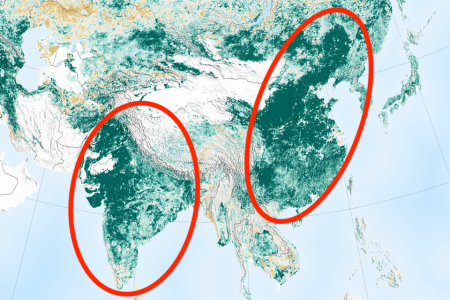March 1, 2019 – NASA’s Earth observation satellites have been taking snapshots and sensing the planet for the last two decades and the images and data show an increase in overall global vegetation. The observations are reported in the February 11th, 2019 issue of the journal Nature Sustainability. A team of contributors includes researchers from the United States, China, India, Germany, France, Denmark and Norway have found results showing a greening Earth.
Why is this happening?
There are both direct and indirect factors.
Direct factors – come from the implementation of afforestation (planting trees where none have been before) and reforestation (the replanting of trees in areas where forestry is practiced) projects in a number of countries. Most notably China and India have been on a tree planting kick. In one day alone recently 800,000 Indian volunteers planted 50 million trees.
The spreading of no-till practices in agriculture has increased ground cover helping the greening process.
Indirect factors – include climate change, CO2 fertilization, nitrogen deposition, and recovery from disturbances such as wildfires, hurricanes, tsunamis, earthquakes, volcanic eruptions, landslides, and other naturally occurring events.
Where is the greening happening?
China accounts for almost a third of the greening with 42% of that coming from afforestation and reforestation, and 32% from croplands. India’s greening is 82% from cropland, and 4.4% from afforestation and reforestation. China’s greening policy and programs are aimed at limiting soil and land degradation, addressing climate change, and reducing air pollution. In both countries because of agricultural intensification food production since 2000 has risen by 35%.
The global average greening by country equals 2.3% per decade over the last two. But most countries don’t meet the 2.3%. Other than China and India, only the European Union and Canada exceed the average.
One of the reasons that some nations aren’t getting greener is because they already have maintained forests and vegetation with little room to increase afforestation or reforestation. One example is Costa Rica.
What technology was used to gather the data?
NASA used its Terra Earth Observation Satellite’s (TEOS) onboard Moderate Resolution Imaging Spectroradiometer (MODIS) to compile changes to the planet’s vegetation cover. TEOS captures an entire image of the planet every 1 to 2 days and through MODIS sees our world through 36 discrete spectral bands measuing everything from cloud coverage and properties, aerosol content both natural and human-made, water vapour, temperature through the vertical column of air, as well as changes to land and ocean surfaces from vegetation to phytoplankton growth. It is MODIS chlorophyll fluorescence spectrum measurements that make it capable of capturing the detailed greening of the planet possible.
What is CO2 fertilization and nitrogen deposition?
Of the indirect factors mentioned above, I thought it would be useful to define CO2 fertilization and nitrogen deposition.
CO2 fertilization describes the consequence arising from increasing amounts of the gas in the atmosphere. Climate change skeptics such as those in the President Trump administration point to the greening as evidence that CO2 is good for life on Earth. And no doubt, the right amount of atmospheric CO2 is good for life on this planet. After all, plants need CO2 to grow. But the other aspect of CO2 is its ability to convert the photons from sunlight into heat. This can also be a good thing, again, when the amounts of the gas in the atmosphere are right. But when CO2 levels rise to a point that causes atmospheric heating beyond the tolerance of many plants, it has a “degreening” effect. For example, when temperatures exceed 32 Celsius (90 Fahrenheit), corn yields begin to drop. Or take wheat, a mean temperature rise of 1 Celsius (1.8 Fahrenheit) is expected to decrease yields by 35 million tons annually which represents 5% of the total crop.
Today our global mean temperature has risen 0.8 Celsius (1.44 Fahrenheit) above pre-Industrial Revolution levels, and based on current trends, projections have us hitting a 1.0 Celsius rise well before 2050. Now take into consideration that the heat in the atmosphere is unequally distributed across the planet and we will see excessively warmer temperatures in polar regions, displaced cold air masses causing polar vortices, and tropical areas around the equator becoming inhospitable.
Nitrogen deposition has a different impact than CO2. It is human activity, namely the burning of fossil fuels, and high-intensity agriculture that are responsible for nitrogen oxides in the atmosphere. Nitrogen is an important plant nutrient and when deposited in forests and fields contributes to global greening. But nitrogen oxides are also greenhouse gases that, like CO2, contribute to global warming. And increased nitrogen oxides in the atmosphere represent a danger to public health, particularly increasing the number of cases of asthma, lung ailments, and heart disease. When Australia set its nitrogen oxide and other particulate matter standards it measured safe levels in the air over a one year period at 0.03 parts per million (ppm), and a maximum in urban areas over a one-hour period of 0.12. But in China nitrogen oxide levels in cities like Shanghai are measured at levels between 15.0 and 51.0 ppm. That’s why China has high rates of respiratory illnesses leading to premature death. It shouldn’t be surprising then that China is aggressively planting trees to increase nitrogen deposition so that the people in its cities can breathe cleaner air.
So is a greener planet a good thing?
Yes and no.
Yes because it shows that through human action we can implement strategies to combat climate change. Afforestation and reforestation create new carbon and nitrogen deposition sinks.
But no, because the greening is a sign that CO2 and nitrogen oxides are increasing and with it, mean temperatures which can reach a tipping point and turn into a “degreening” and runaway climate change in a few more decades.








